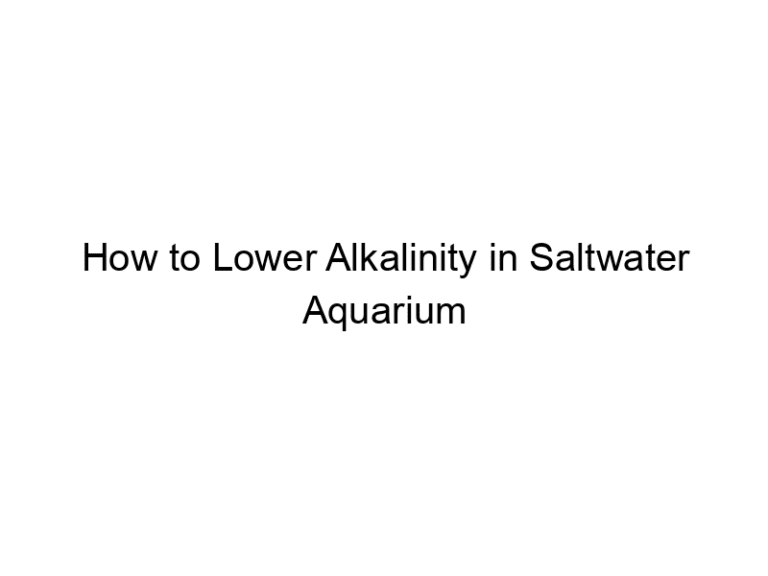High alkalinity can harm corals and fish, making it crucial to maintain balanced levels. Keeping a saltwater aquarium is rewarding but demands careful water management. Alkalinity refers to the water’s ability to neutralize acids, playing a key role in maintaining pH stability.
When alkalinity levels rise too high, it can cause stress and harm to your marine creatures. Lowering alkalinity involves steps like partial water changes, using specific chemicals, and testing water regularly. It’s essential to understand these methods to keep your aquarium thriving. In this guide, we will explore effective ways to lower alkalinity and ensure the well-being of your saltwater inhabitants.
Lower Alkalinity In Saltwater Aquarium
Lowering alkalinity in a saltwater aquarium involves performing regular water changes with low-alkalinity water. Use a pH buffer or a specialized alkalinity reducer for better results. Consistently monitor levels to maintain a balanced environment.
Maintaining proper alkalinity in your saltwater aquarium is crucial. High alkalinity can harm marine life, causing stress and health issues. Let’s explore effective ways to lower alkalinity in your saltwater tank.
Regular Water Changes
Performing regular water changes can help. This method dilutes the excess alkalinity:
- Frequency: Change 10-20% of the water weekly.
- Fresh saltwater: Use water with the correct alkalinity level.
- Consistency: Regular changes keep water parameters stable.
Using A Buffer
Buffers can adjust your water’s alkalinity. Choose a suitable buffer for your tank:
- Commercial buffers: Follow the instructions carefully.
- Natural buffers: Crushed coral or limestone can be used.
- Monitor: Regularly check alkalinity levels to avoid sudden changes.
Adjusting The Amount Of Baking Soda
Baking soda can affect water chemistry. Reduce the amount you add:
- Measurement: Use less baking soda during water preparations.
- Gradual reduction: Decrease slowly to avoid shocking the system.
- Observe: Watch for changes in alkalinity and adjust accordingly.
Adding Co2
CO2 can help lower alkalinity. Use it carefully to avoid harming your fish:
- CO2 reactor: Install a reactor in your tank.
- Monitor: Check pH and alkalinity levels regularly.
- Adjust: Increase or decrease CO2 based on readings.
Using Reverse Osmosis (ro) Water
RO water is free from impurities. It helps in reducing alkalinity:
- Filtration: Install an RO unit for water changes.
- Mixing: Combine RO water with salt mix to achieve desired levels.
- Testing: Always test water parameters before adding to the tank.
Adding Acidic Substances
Acidic substances can help lower alkalinity. Use them cautiously:
- Vinegar: Add small amounts of vinegar to the tank.
- Muriatic acid: A stronger option but requires careful handling.
- Dosing: Start with small doses and increase gradually.
Reducing Feeding
Overfeeding can increase waste and alkalinity. Cut down on food:
- Smaller portions: Feed fish less food at each meal.
- Frequency: Reduce the number of feedings per day.
- Clean up: Remove uneaten food promptly.
Using Natural Sea Water
Natural sea water has balanced alkalinity. Use it for water changes:
- Collection: Ensure it’s clean and free from pollutants.
- Mixing: Gradually replace tank water with natural seawater.
- Consistency: Regular use keeps alkalinity in check.
By following these methods, you can effectively lower the alkalinity in your saltwater aquarium and ensure a healthy environment for your marine life.
How To Raise Alkalinity In Saltwater Aquarium
To lower alkalinity in a saltwater aquarium, conduct partial water changes. Use reverse osmosis water to dilute the existing alkalinity.
Maintaining the right alkalinity in your saltwater aquarium is crucial. If the levels are too low, your tank’s inhabitants could suffer. Here’s how to raise alkalinity effectively.
Test Your Water First
Before making any adjustments, always check your water parameters.
- Accurate Testing: Use a reliable test kit for precise results.
- Measure Regularly: Test your water at consistent intervals.
- Identify Trends: Keep track of changes over time.
Use Alkalinity Buffers
One of the easiest ways to raise alkalinity is by using buffers.
Alkalinity buffers come in liquid or powder forms. They are easy to dose and effective.
Baking Soda Solution
A simple and cost-effective method is using baking soda.
- Mix Baking Soda: Dissolve a small amount in RO/DI water.
- Add Slowly: Introduce the solution gradually to your tank.
- Monitor Levels: Check alkalinity after each addition.
Water Changes
Sometimes, a water change can help stabilize alkalinity.
Regular water changes with a high-quality salt mix can boost alkalinity. It’s a simple yet effective strategy.
Adjust Calcium Levels
Alkalinity and calcium are interconnected.
- Test Calcium: Ensure your calcium levels are balanced.
- Use Supplements: If needed, add calcium supplements.
- Monitor Both: Keep an eye on both parameters.
Consider A Calcium Reactor
For more advanced aquarists, a calcium reactor can be useful.
A calcium reactor helps maintain both calcium and alkalinity. It’s an automated solution that ensures stability.
Maintain Consistency
Consistency is key to maintaining proper alkalinity.
- Routine Checks: Make testing a habit.
- Regular Dosing: Follow a dosing schedule.
- Avoid Large Shifts: Make gradual adjustments.
By following these steps, you can ensure a healthy environment for your saltwater aquarium.
Frequently Asked Questions
How Do You Reduce Alkalinity In A Saltwater Aquarium?
To reduce alkalinity in a saltwater aquarium, perform partial water changes using reverse osmosis (RO) water. Use a high-quality salt mix with lower alkalinity levels. Adding a buffer solution designed to lower alkalinity can also help. Regularly test water parameters to monitor changes.
What Causes High Alkalinity In A Saltwater Aquarium?
High alkalinity in a saltwater aquarium is caused by excessive carbonate and bicarbonate levels. Overuse of supplements and improper water changes can also contribute.
How Do You Lower Alkalinity Quickly?
To lower alkalinity quickly, add muriatic acid or sodium bisulfate to the water. Test levels frequently. Adjust as needed.
Does Vinegar Lower Alkalinity In A Reef Tank?
Yes, vinegar can lower alkalinity in a reef tank. It reacts with bicarbonates, reducing alkalinity. Use it carefully to avoid sudden changes.
Conclusion
Properly managing alkalinity keeps your saltwater aquarium healthy. Regularly test water parameters. Maintain a consistent routine. Use water changes and additives carefully. Always research products before using them. Your aquarium’s inhabitants will thrive with balanced alkalinity. Ensure a stable, vibrant underwater environment.
Happy aquascaping





